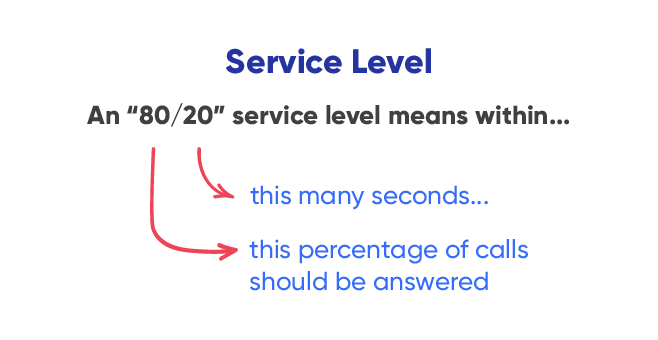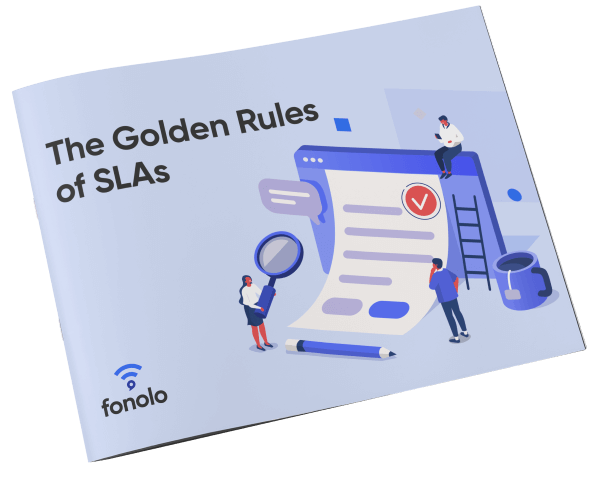In the world of contact center metrics, service level has always held a special place. This metric is universally understood across the industry, and clearly conveys how quickly customer calls are answered by support agents. Its origins go back over five decades, to the earliest days of call centers.
What is the Purpose of Service Levels?
Call center service levels are, broadly speaking, a commitment to a particular average speed of answer, or ASA. And for many call center managers, maintaining these service levels is a top priority. It can be a difficult task when unexpected call volume spikes hit. Still, for some outsourced call centers (BPOs), missing a service level could result in financial penalties — or even the loss of their contract!
With so much riding on this metric, it’s shocking to see how many call centers choose their service level arbitrarily or with minimal consultation. It’s not enough to blindly rely on the 80/20 rule, but many businesses are doing just that!
What is a Call Center Service Level of 80/20?
Service level is always given as a pair of numbers:
- A percentage value
- A time value in seconds.
An 80/20 service level in a call center simply means that 80 percent of the calls will be answered within 20 seconds.

Where Did the 80/20 Service Level Rule Come From?
The longevity of service level is astonishing if you consider the enormous changes that have occurred in customer service technology over the last few decades. Even more astonishing is that most call centers would name the identical target value for that metric: the magical “80/20.”
You might be thinking that this standard is based on careful analysis. It’s not. There is no 80/20 rule or principle at all. It was arbitrarily chosen in the early days of call center technology.
After speaking to numerous experts in this field, two things became clear.
- The most popular service level is 80/20
- No one knows where this standard came from!
Some analysts say that 80/20 principle was “hard-wired” into the original call center platforms made by Rockwell in the 1970s. Rockwell, which got out of the call center business in 2004, was one of the pioneers of the technology. There’s debate over whether Ericsson or Rockwell was actually first to market with a true Automatic Call Distributor.
In other places, you might read that the 80/20 principle came from an AT&T study conducted some 30 years ago, that found that callers tended to hang up after 20 seconds in the queue.
Whatever the story is, clearly we need to approach this “standard” with skepticism.
The ’80/20 rule’ is just an arbitrary industry standard
Call center veteran Lawrence Whitaker says he suspects that the 80/20 “standard” gets a false validity boost simply because it sounds like the Pareto Principle. You know, that old saying about “20% of the work will take 80% of the time.” But clearly that’s a spurious connection.
3 Problems with the 80/20 Service Level for Contact Centers
The case against worshipping service level has been made by many contact center analysts and industry veterans. Most of the complaints boil down to the idea that, if too much attention is focused on optimizing for this metric, other facets of the call center can suffer.
1. Traditional metrics are ‘lagging indicators’
Harvard Business Review put it succinctly: “Instead of worrying about typical customer satisfaction measures, such as share of wallet and net promoter scores, organizations should look at the number of new value-adding service ideas put into practice. It’s not that conventional metrics are unimportant, the researchers say, but because they are ‘lagging indicators’ they can bog down efforts to achieve rapid, dramatic change.” So that’s a broad strategic reason to de-emphasize service level.
2. Service level metrics don’t correlate with customer satisfaction
Gemma Caddick, a Forecast Analyst at Severn Trent Water, brings up the first problem. The 80/20 rule gives us a goal for 80% of the customers. “But what it doesn’t tell us is what happens to the 20% of customers that are not answered in 20 seconds.”
The very nature of the service level metric means that variability can get swept under the rug. Let’s say your call center successfully met your 80/20 target all day; so you know that 80% of the calls were answered in less than 20 seconds. But you really don’t know anything about how those calls went. For example, you know nothing about how bad the 20% of unanswered were. Were their wait times 30 seconds or 10 minutes? This variability is critical.
Variability Matters
In his book, The Executive Guide to Call Center Metrics, James Abbott writes: “In today’s centers, variability is the largest driver of cost… the bigger the variation the more costly the operation.”
Clearly, we have to be careful not to get wedded to any particular metric. Otherwise, we run the risk of causing horror stories like those of customers being put to the back of the call queue so that customers who are still within the service level limits can be answered and targets met.
Let’s say your call center successfully met your 80/20 target all day, so you know that 80% of the calls were answered in less than 20 seconds — really that tells you very little about what went on that day: You still don’t know anything… Click To Tweet
What percentage of those calls resulted in a second call because the agent wanted them off the phone quickly? Or how many opportunities to upsell a customer were missed because the customer support agent didn’t have the time to build a relationship with the customer?
3. Callers do not abandon at a constant rate
If we take the time to understand why our customers are calling, we may find that they may stand to wait a little longer to speak to someone. And if we know what customers are willing to tolerate, we can set service levels that allow us to deliver exceptional customer service. Even if that means they have to wait on the phone for 40 seconds, or even an entire minute.
As Joe Barkai points out, “Diagnostic Strategies research shows that once they are placed in the queue, callers do not abandon calls at a constant rate…As long as the service level target is longer than the abandonment threshold, callers will wait.” It’s worth testing that limit to see if you can raise other important metrics like CSat or FCR.
If you have multiple skill groups in your call center, another issue arises. Averaging across the groups to get a single service level can obscure problems in specific groups. Measuring each group separately is smarter, but that leaves you with too many numbers to interpret. This is actually an argument against dividing your workforce into skill groups.
How Do You Set the Right Service Level for Your Contact Center?
A call center’s service level should be based on what that call center can reasonably achieve, given its resources and given the expected call volume.
Coming up with this figure requires deep analysis and hard work. And it’s work that most call center managers don’t have the time or tools to do. So if your average speed of answer service level is currently operating under 80/20, odds are good those numbers are not the right ones for your call center, and the proper analysis was never done!
if your average speed of answer service level is currently operating under 80/20, odds are good those numbers are not the right ones for your call center, and the proper analysis was never done! #slas #contactcenters Click To TweetModeling SLAs in Your Call Center
Erlang equations to the rescue
The only way to properly model the service level in your call center is to use the Erlang equations. It’s understandable that many call center managers today are not comfortable with Erlang, because when you look it up, you see equations like this:

Just look at that beast with its strange Greek letters and exclamation points… yeesh! To get more comfortable with the concept, you can think of Erlang as a translator box, where you put in values like calls per hour, handle times, and the number of agents available.
These are “deterministic” values, in that they are easily measured. What you get as output are the answers to “probabilistic” questions such as, “What are the odds a call will have to wait in a queue?” or “What are the odds a call will wait more than 30 seconds?”

Another important reason to be comfortable with Erlang is that it’s the only way you can do a proper analysis of call volume “spikes”. For a walk-through on that kind of analysis, check out this blog post. Fortunately, there are many easy (and free) ways to get back that “feel”.
Easy Erlang tools:
- Experiment with an online Erlang C calculator like this one.
- Another option is the Excel macro you can download here.
More Service Level Pitfalls
There are other points to consider when setting service level targets for your company.
1. Service level is an underspecified metric
Another problem with 80/20, or any service level expressed in this way, is that it is underspecified. We have to also select a time period for calculating the average. Are we going to average over calls every hour? Every day? The interval matters more than you might think.
The topic inspired a lively LinkedIn discussion where call center consultant Rebecca Wise Girson said:
“The bigger the time period, the easier it is to ‘look’ like you’re providing a good customer experience. Measuring the percentage of intervals throughout the day that you meet your SL goal is a more telling metric than measuring only to daily, weekly or monthly averages.”
2. SLAs can be gamed
In case you were wondering, long intervals make it easy to game this metric. One call center industry expert shared a story about how working towards a weekly or monthly SL goal allows for many periods of poor performance to be averaged away. Some organizations play averages to meet SLAs by intentionally overstaffing periods (sometimes with overtime) just to make up for periods with low performance.
This waste of labor dollars does nothing to change the negative experience of customers who called during a period with low service levels.
3. Compliance Rate Makes Your Service Level More Meaningful
Trigger alert. More math ahead.
So now we’ve picked a time limit (say, 20 seconds) and a percentage target (80%) and a time period (one hour). Is this now a fully specified metric? Technically yes, but in practice, there’s another step before the metric is actually useful because now we have a set of eight scores at the end of an eight hour day. Are we going to average them together? That could hide important variability, as mentioned in the section above.
But if we don’t somehow aggregate the data, we will have a hard time talking about performance over longer time scales.
A better approach is to agree on some kind of “compliance rate” where you calculate how many of the time intervals had service levels that met the target. For example: “We met our service level targets in six out of eight time ranges today.” This could be further condensed into saying “We had a 75% compliance rate.”
Now we are finally able to state a fully specified goal for a call center: “We want to answer 80% of all calls within 20 seconds, averaged each hour, 75% of the time.”
Contact Centers are Moving Beyond 80/20 Service Levels
It seems call center managers are learning to look beyond the old 80/20 standard. In one report by Call Center Helper, researchers asked participants to rank the importance of different metrics in their operation. Service level came in fourth place, behind customer satisfaction, FCR, and advisor satisfaction!
A report by Natterbox, NICE InContact, Jabra, and Serenova that surveyed 250 contact centers found that there are, in fact, a wide range of service levels in use today, ranging from 50/40 to 100/180.
Benefits of Relaxing Target Answer Times
In a post on CallCentreHelper.com, the authors reflect on why companies might be willing to relax the target answer times (i.e. leave callers on hold longer):
“Well, firstly, there are the obvious cost benefits, in that you’ll likely need fewer [agents at] … a lower SLA. The company might have also investigated how varying their SLA impacts their customer satisfaction. If they found a low correlation between the two metrics, there is a business case for lowering SLAs … [but] If you were to do this … look at the impact service level has on your abandon rate, to ensure that you won’t lose too many calls.”
Here’s a great case study on a company that reduced abandonment rates.
Back to Picking the Right Service Level
Picking the right service level for your company really boils down to balancing your company’s desire to deliver customer satisfaction (or customer engagement or net promoter score) with the cost you’re willing to bear to achieve it.
TIP:
A great way to reduce — or even eliminate — abandoned calls is to replace hold times with a call-back solution!
One excellent explanation of the process comes from consultant Stuart Crutchfield who suggests the following:
- How do I want to prioritize my customers’ wait time? (This often can reflect customer lifetime value or propensity to buy, where customers of greater actual, or potential, value are prioritized for a prompt answer.)
- Having segmented my customers by some measure of importance, after how many seconds in the queue does their abandonment rate start to materially increase?
- What is the impact of an increased abandonment rate on our customers’ satisfaction (compare higher abandonment groups to a control group)?
Another approach to take is to look at the standards guides published by COPC which some in the industry use as benchmarks. They have separate guides for internal operations, outsourced operations, healthcare and vendor management.
Don’t Get Stuck to an 80/20 Service Level
With the knowledge that the 80/20 service level is a mere arbitrary goal for call centers, we are freed to tailor it to our own uses. Your customers may well be willing to wait longer than 20 seconds to talk to someone, as long as they don’t have to wait indefinitely.
They may even prefer to find the answer themselves through a better self-service option, or dare we say it, receive a call-back from a customer support agent at a later time.
Meeting high service levels in your contact center is expensive, and may even be a waste of time if SLAs are not aligned with corporate strategy or moving the needle on customer satisfaction scores.
Explore what your customers really want. And consider how you can align that with your corporate goals before you set a service level for your call center. And be willing to adjust them when you get new data coming through.
ASA and Service Levels Working Together
As we’ve discussed, an 80/20 service level doesn’t tell you much about the 20% of callers who are left on hold. Enter ASA, or average speed of answer: the metric that tells you how quickly your agents are answering all calls. A low service level will naturally reduce your ASA, so it’s important to keep an eye on both of these metrics and understand how they work together to achieve the best results. Put another way, when SL is considered along with ASA, you can get a holistic view of your contact center operations.
Tips for Improving your Service Levels and ASA
Call volume forecasting
Dive into your data history and analyze call volume trends. Are there certain times of the day, week, or month when you consistently see spikes in demand? Consider the time of year as well — depending on your industry, there will likely be seasonal periods when you’re busier than normal (summer and winter holidays, tax season, flu season, etc.).
Strategic staffing
Once you have the data to forecast demand for your call center, align your staffing efforts. There’s nothing worse than being short-staffed and blindsided by a sudden wave of calls, so be sure you have enough agents available during busy times.
Call-back technology
It’s impossible to forecast customer demand and staff your team with 100% accuracy. Anything from a website issue to a public crisis can cause a flood of calls with little warning. Call-back technology makes an excellent safety net by offering callers the option of a call-back so they don’t have to wait on hold. This helps mitigate customer frustration while protecting your KPIs, including ASA and service level.

The Golden Rules of SLAs
If you’re looking to quickly study up on SLAs, look no further. Download this free white paper to become an expert.


